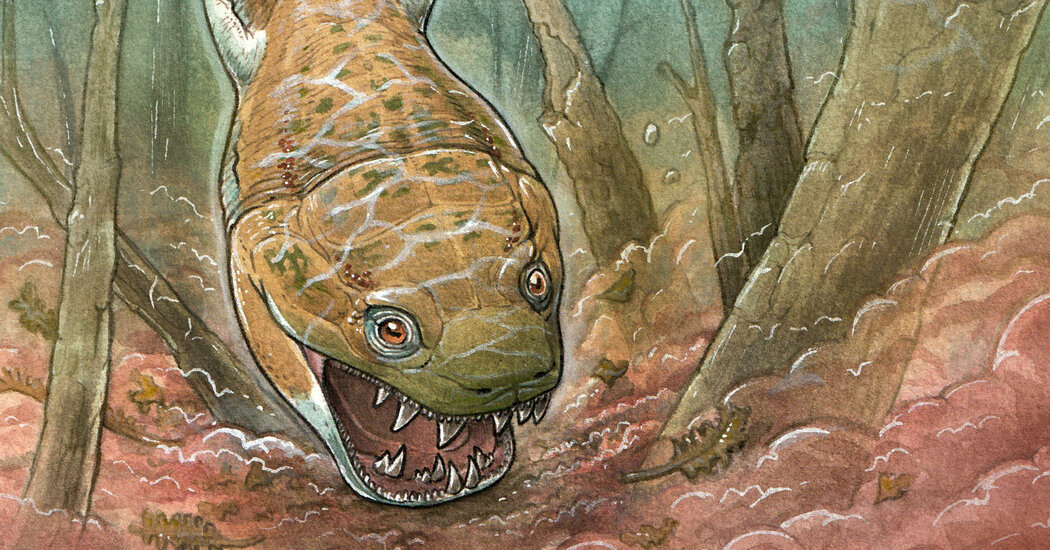
Some 280 million years in the past, a immense predator glided in the course of the cold waters of a supercontinent within the Southern Hemisphere. The eight-foot-long hunter had slight limbs, an eel-like frame and a flat head stuffed with jutting fangs. And in keeping with current concepts about vertebrate evolution, it shouldn’t have existed.
“It was displaced in time, displaced regionally and also far too big,” stated Claudia Marsicano, a paleontologist on the College of Buenos Aires and an writer of a paper describing the animal within the magazine Nature on Wednesday. “There were a lot of things that made it unique.”
The gigantic salamander-like creature, which Dr. Marsicano and her colleagues named Gaiasia jennyae, may just simplest had been a relic of a folk idea to had been extinct for hundreds of thousands of years. Their discovering may counsel that alternative analysis at the emergence of tetrapods — vertebrates with 4 limbs and toes in lieu of fins — is to deliver.
Spencer Lucas, a paleontologist on the Fresh Mexico Museum of Herbal Historical past and Science who was once no longer concerned learn about, stated that the invention “is not enough to force a rethink of most of what we think about late Paleozoic tetrapod evolution. But it is a nudge in that direction.”
Dr. Marsicano and her colleagues found out Gaiasia fossils in 2014 and 2015 throughout successive expeditions to the brutal deserts of the Huab Basin of northwest Namibia in Southern Africa. They recovered fossils from 4 animals, together with a couple of skulls and a just about whole skeleton.
Piecing in combination the specimens, the group says that Gaiasia belonged to a folk of bigheaded, swamp-dwelling vertebrates known as colosteids. This folk had fracture off from alternative land animals lengthy prior to the ancestors of extra trendy lineages like amphibians, reptiles and mammals developed.
Kind of 400 million years in the past, colosteids and alternative early tetrapods developed from fish amid equatorial forests. Paleontologists’ working out of the Paleozoic Pace comes virtually solely from the learn about of deposits present in North The united states and Europe, stated Jason Pardo, a paleontologist on the Garden Museum in Chicago and an writer at the paper.
So when archaic tetrapods disappeared from the ones forests 307 million years in the past, researchers assumed they went extinct far and wide.
However Gaiasia grew to become up in rocks 20 million years nearest than anticipated, Dr. Marsicano stated, early within the Permian Duration. And year up to now recognized contributors of the creatures’ folk had skulls that would are compatible in an individual’s hand, Dr. Marsicano stated, Gaiasia’s cranium reached two toes lengthy or extra, making it the most important animal of its type ever discovered.
The situation that Gaiasia lived in was once in particular mischievous. All the way through the early Permian, what’s lately Namibia lay alongside the southern supercontinent of Gondwana, a ground thick with partitions of glaciers and chilly, temperate woodlands like the ones present in Canada or Norway.
Gaiasia’s look in this kind of ground can be like discovering a crocodile residing fortuitously in a puddle in Manitoba, Dr. Pardo stated, “but this animal was certainly able to make a living and get quite large in that environment.”
Within the forests across the Equator, pageant with bulky fish — and nearest, the bigger kin of recent amphibians — may have stored early tetrapods mini, the group concluded. However those animals appear to have had higher good fortune within the cool waterways within the silhoutte of Gondwana’s glaciers even because the Equator’s tropical woodlands splintered into dryer ecosystems stuffed with finbacked predators like Dimetrodon.
Gaiasia and its accommodation upload an mischievous crease to the tale of tetrapod evolution, Dr. Marsicano stated. Researchers have tended to think that almost all tetrapods developed within the tropics and lingered there, with extra specialised teams spreading into cooler climates simplest round 280 million years in the past. Gaiasia’s presence, at the alternative hand, means that its ancestors reached prime latitudes prior to that age.
Early tetrapods “were more adapted to different types of environments from the beginning,” Dr. Marsicano stated.
Presen the worldwide tale of tetrapod evolution is primarily based in large part on information from fossils present in North The united states and Europe, Dr. Pardo stated, the invention of Gaiasia highlights the worth of learning websites in South The united states and Africa, that have traditionally been marginalized in paleontology.
“Getting these faunas from the Southern Hemisphere is really critical to understanding the story of our own lineages,” Dr. Pardo stated. “Especially the question of whether those are just local stories, as opposed to something happening on a global scale.”











